BMW M3
The BMW M3 is a high-performance version of the BMW 3 Series, developed by BMW's in-house motorsport division, BMW M GmbH. M3 models have been produced for every generation of 3 Series since the E30 M3 was introduced in 1986.
| BMW M3 | |
|---|---|
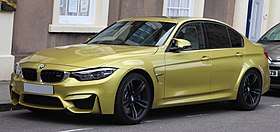 | |
| Overview | |
| Manufacturer | BMW M GmbH |
| Production | 1986–2018 |
| Body and chassis | |
| Class | Compact executive car (D) |
| Layout | Front-engine, rear-wheel drive |
| Related | BMW 3 Series BMW M4 |
The initial model was available in a coupé body style, with a convertible body style added soon after. M3 sedans were available during the E36 (1994–1999) and E90 (2008–2012) generations. Since 2015 the M3 has been solely produced in the sedan body style, due to the coupé and convertible models being rebranded as the 4 Series range, making the high-performance variant the M4.[1][2]
Upgrades over the regular 3 Series models include engines, handling, brakes, aerodynamics, lightweight materials and various interior upgrades.
E30 generation (1986–1991)
| BMW M3 (E30) | |
|---|---|
.jpg) BMW M3 Evolution II | |
| Overview | |
| Production | 1986–1991 |
| Body and chassis | |
| Body style | 2-door coupe 2-door convertible |
| Powertrain | |
| Engine | 2.0—2.5 L S14 I4 |
| Transmission | 5-speed manual |
| Dimensions | |
| Wheelbase | 2,562 mm (100.9 in) |
| Length | 4,345 mm (171.1 in) |
| Width | 1,680 mm (66.1 in) |
| Height | 1,370 mm (53.9 in) |
The first BMW M3 was based on the E30 3 Series and was produced from March 1986 to June 1991.[3][4] The majority of E30 M3s were produced in the coupe body style, but limited volumes of convertibles were also produced.[5]
The body shape for the M3 has been changed significantly, among other things to further improve the torsional rigidity, the Cd and the driving dynamics. The suitability for racing was in the foreground, therefore sacrifices in comfort and production costs could be made. The modifications included eye-catching fender flares to allow a wider track.
The front spoiler, the rear apron, sill panels, as well as changes to the body in the area of the rear window (C-pillar) and the trunk lid improved the aerodynamics. For aerodynamic reasons, the rear window has been flattened and the tailgate made of light, glass fiber reinforced plastic and raised by approximately 40 mm for better air flow. The changes in the rear area resulted in lower lift forces and better straight-line stability. In addition, the windscreen was glued in - and not, as with the other E30 models, framed with a window rubber and piping. As a result, the M3 achieved a relatively low drag coefficient of Cd=0.33 instead of 0.38 as in the normal model. Among other things, the subsequent conversions of normal 3s to the M3 version can usually be identified on the C-pillar. The only exterior body panels the regular 3 Series and the M3 shared were the bonnet, roof panel, sunroof and door inner panels.
The brake calipers, rotors and master cylinder were unique to the M3 model.
The transmission was a Getrag 265 5-speed manual. European models were outfitted with a dogleg version with close ratios and a 1:1 ratio for fifth gear. North American models used a traditional shift pattern and had wider gear spacing with an overdriven fifth gear. A clutch-type limited-slip differential was standard equipment.
The official kerb weights of the 1986 M3 coupe was 1,165 kg (2,568 lb) and the 1988 M3 convertible was 1,360 kg (2,998 lb).[6][7] The kerb weight for the US specification M3 was 1,240.6 kg (2,735 lb).[8]
In 2004, Sports Car International named the E30 M3 car number six on the list of Top Sports Cars of the 1980s. In 2007, Automobile Magazine included the E30 M3 in their "5 greatest drivers cars of all time" under their 25 Greatest Cars of All Time.
.jpg) Coupe
Coupe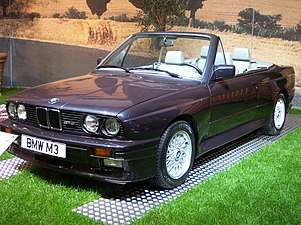 Convertible
Convertible
Engine
The E30 M3 used the BMW S14 four-cylinder engine, a high-revving DOHC design with a head closely based on that of the BMW S38 six-cylinder engine and the block from the BMW M10 four-cylinder engine.[9][10] In countries where the M3 was sold with a catalytic converter, the initial versions were rated at 143 kW (195 PS; 192 hp) and had a top speed of 235 km/h (146 mph).[11] In countries where a catalytic converter was not fitted, the engine generated 147 kW (200 PS; 197 hp).
In September 1989, European M3s were upgraded to the 158 kW (215 PS; 212 hp) (as introduced on the Ravaglia special edition model), increasing the top speed to 240 km/h (149 mph).[11]
Suspension
Differences to the regular E30 models included:
- 5-stud wheel hubs
- offset control arm bushings in the front suspension, for increased caster angle
- aluminium control arms
- revised front strut tubes with bolt on kingpins and swaybar mounted to strut tube, similar to the E28 5 Series
- front wheel bearings and brake calliper bolt spacing from the E28 5 Series
Special editions
Evolution
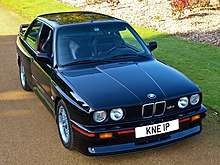
The sportier "Evolution" model (also called "EVO2") introduced in 1988 was rated at 162 kW (220 PS; 217 hp).[12] Other changes included larger wheels (16 X 7.5 inches), thinner rear and side window glass, a lighter bootlid, a deeper front splitter and additional rear spoiler. A total of 505 cars were produced, including 40 sold in France as the "Tour de Corse".[13]
Sport Evolution
A more powerful and lighter "Sport Evolution" model (sometimes referred as "EVO3") with a limited production run of 600 units was produced with an upgraded 2,467 cc (150.5 cu in) engine rated at 175 kW (238 PS; 235 hp) at 7,000 rpm and 240 N⋅m (177 lbf⋅ft) at 4,750 rpm.[13][14] The top speed was increased to 250 km/h (154 mph).[11] Sport Evolution models have enlarged front bumper openings and an adjustable multi-position front splitter and rear wing. Brake cooling ducts were installed in place of front foglights.
Ravaglia and Cecotto editions
In April 1989, the Ravaglia and Cecotto limited editions were released, both named after Deutsche Tourenwagen Meisterschaft (DTM) racing drivers. Power was increased to 158 kW (215 PS; 212 hp) with a catalytic converter.[12] Cecotto Edition production consisted of 480 cars, plus 80 cars for the Swiss market de-tuned to 155 kW (211 PS; 208 hp) to meet Swiss emissions limits. The production run for the Ravaglia Edition consisted of 25 cars.[13]
M3 Pickup prototype
In 1986, BMW produced an "M3 Pickup" prototype pickup truck, based on the convertible model. The M3 Pickup used the narrower body of regular E30 models and was originally powered by the 2.0 litre version of the S14 engine from the Italian-specification M3. It was used as a transporter for roughly 26 years before it was officially retired in 2012.[15][16]
Production volumes
Total production of the E30 M3 was 17,970 cars.[13][17]
| Model Code | Market | Power | Units | |
|---|---|---|---|---|
| Coupe | ||||
| AK01 | Euro spec | 147 kW (200 PS; 197 hp) | 5,187 | |
| AK05 | 143 kW (195 PS; 192 hp) | 4,591 | ||
| 158 kW (215 PS; 212 hp) | 1,506 | |||
| AK07 | 175 kW (238 PS; 235 hp) | 600 | ||
| AK03 | U.S. spec | 192 hp (143 kW) | 5,300 | |
| Convertible | ||||
| BB01 | Euro spec | 147 kW (200 PS; 197 hp) | 136 | |
| BB05 | 143 kW (195 PS; 192 hp) | 174 | ||
| 158 kW (215 PS; 212 hp) | 476 | |||
Motorsport
.jpg)
The E30 M3 competed in many forms of motorsport and was highly successful in touring car racing. The E30 M3 road car was homologated for Group A racing, to compete against models such as the Mercedes-Benz W201 190E. In full race trim, the 1988 M3's 2.3 L (140 cu in) naturally aspirated 2.3 L engine was rated at approximately 224 kW (300 hp).[18] The E30 M3 won the 24 Hours Nürburgring five times (1989, 1990, 1991, 1992 and 1994) and the Spa 24 Hours four times (1987, 1988, 1990 and 1992), other competing against cars with significantly larger or turbocharged engines.
To keep the car competitive in racing following year-to-year homologation rules changes, homologation specials were produced and sold in limited volumes. These include the Evo 1, Evo 2, and Sport Evolution, with upgrades including weight reduction, improved aerodynamics, taller front wheel arches (to allow 18-inch wheels to be used in DTM racing), bigger brake ducts and more power. With the introduction of the 2.5 L evolution engine into racing in 1990, power increased to approximately 283 kW (380 hp).[19]
The M3 also competed as a rally car, with Prodrive-prepared examples contesting several national championships and selected rounds of the World Rally Championship between 1987 and 1989. By the latter year, the cars, based on the regular M3, were equipped with six-speed gearboxes and produced 221 kW (300 PS; 296 hp). The M3 was not very competitive with the four-wheel-drive cars on loose surfaces, but a very effective car on asphalt. Its most notable success was victory on the Tour de Corse in 1987, driven by Bernard Beguin.
Championships
- World Touring Car Championship; 1 title (1987)
- European Touring Car Championship; 2 titles (1987 and 1988)
- British Touring Car Championship; 2 titles (1988 and 1991)
- Italia Superturismo Championship; 4 titles (1987, 1989, 1990 and 1991)
- Deutsche Tourenwagen Meisterschaft; 2 titles (1987 and 1989)
- Australian Touring Car Championship; 1 title (1987)
- Australian 2.0 Litre Touring Car Championship; 1 title (1993)
- Australian Manufacturers' Championship; 2 titles (1987 and 1988 – both shared)
- AMSCAR Series; 2 titles (1987, 1991)
- Irish Tarmac Rally Championship; 1 title (1990)
E36 generation (1992–1999)
| BMW M3 (E36) | |
|---|---|
 | |
| Overview | |
| Production | 1992—1999 |
| Body and chassis | |
| Body style |
|
| Powertrain | |
| Engine |
|
| Transmission | |
| Dimensions | |
| Wheelbase | 2,700 mm (106 in) |
| Length | 4,430 mm (174 in) |
| Width | 1,710 mm (67 in) |
| Height | 1,370 mm (54 in) |
The M3 model of the E36 3 Series was released in November 1992 and was initially available as a coupé only, with a convertible version added in 1994. A sedan version was also added in December 1994, to fill in the gap caused by the lack of a BMW M5 sedan model between the end of E34 M5 production in 1995 and the launch of the E39 M5 in 1998.
In September 1995, a facelift version of the coupe was introduced. Changes included the engine displacement increasing to 3.2 L (195 cu in), the manual transmission upgrading from a 5-speed to a 6-speed,[20] different wheels and clear indicator lenses. The facelift changes were applied to the sedan model in November 1995 and the convertible model in February 1996.[21] The kerb weight of the 1996 M3 coupe in European specification is 1,515 kg (3,340 lb).[22]
The facelift also saw the introduction of a 6-speed "SMG" automated manual transmission,[23] the first time an automatic transmission was available on an M3 outside the United States. The SMG transmission was praised for its fast shift times and operation in performance situations, but criticised for behaviour in everyday driving situations.[24]
In 1996, BMW M hand-built an E36 M3 Compact prototype as an M-car which would appeal to younger customers. It included various performance and styling features of the E36 M3, including the 3.2 litre S50 engine. The M3 Compact was reviewed in the German magazine 'Auto Motor und Sport',[15][16][25] however it did not reach production.
_coupe_02.jpg) coupe
coupe.jpg) convertible
convertible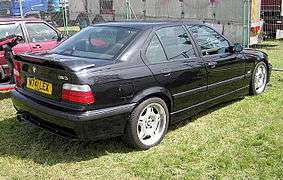 sedan
sedan
Engine
The E36 M3 is powered by the BMW S50 straight-six engine. It was the first M3 to use a six-cylinder engine, which has since been used the majority of M3 models (albeit in turbocharged form since 2014).
In most countries, the initial 2,990 cc (182 cu in) version generated 213 kW (286 hp) at 7,000 rpm and 320 N⋅m (236 lb⋅ft) at 3,600 rpm. North American models (except for the limited edition Canadian "M3 Euro-Spec" model) used the less powerful BMW S50B30US engine instead.
The facelift models in late 1995 were upgraded to a 3,201 cc (195 cu in) version of the BMW S50 engine, generating 236 kW (316 hp) at 7,400 rpm and 350 N⋅m (258 lbf⋅ft) at 3,250 rpm.[26] North American models used the less powerful BMW S52 engine instead.
Special editions
M3 GT (Europe)
.jpg)
In 1994, BMW produced the limited-edition M3 GT as a racing homologation special for Europe,[27] in order to compete in the FIA-GT class II, IMSA GT and international long-distance races.[28] A total of 356 cars were produced, All in left-hand drive for mainland Europe. The UK received a special GT trim limited to 50 cars with only the cosmetic upgrades of the Homologation special. [11]
The engine was the European-specification S50B30, which was upgraded with larger camshafts and a higher compression ratio, resulting in peak power of 220 kW (295 hp) at 7,100 rpm.[29]
All M3 GTs only came in one single colour, British Racing Green. Other changes include a deeper and adjustable front splitter, higher rear double wing, aluminum doors, wheels measuring 17 x 7.5 inches at the front and 17 x 8.5 inches at the rear, stiffer front suspension, a cross-brace and a strut brace. The M3 GT is approximately 30 kg (66 lb) lighter than the regular M3 and has a derestricted top speed of 275 km/h (171 mph).
M3 Evolution Imola Individual
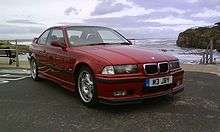
The M3 Evolution Imola Individual is a limited-edition car (50 for the United Kingdom). The engine and performance characteristics of the car were unchanged from the 1996+ euro M3, and a special exterior and interior colour combination was once again chosen by BMW UK; Imola red (405) paint with Nappa leather & Amaretto seats in Imola red and anthracite seats. It also included side airbags, the M3 GT Class II rear spoiler, front class II corner splitter extensions, electric seats, and double-spoke polished alloy wheels.
Prior to the release of the Imola Individual there was a pre-production model made which was used as the basis of the special edition, it featured the Class II front splitter and rear spoiler, special order Imola red Paint, special order Nappa + Anthracite Amaretta interior, SMG gearbox, GSM Phone Kit, headlamp washers and double-spoke polished alloy wheels.[30][31]
M3 Lightweight (U.S.)
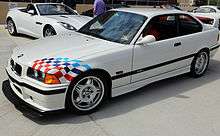
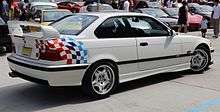
Following the introduction of the E36 M3, racing teams in the United States began pressuring BMW for a homologation version in order to compete in sports-car racing.[32][33] As a result, the 'M3 Lightweight' was introduced in 1995. The cars came without a radio (although the speakers were installed and the car pre-wired for the radio), air conditioning, leather seats, tool kit or a sunroof. The doors have aluminum skins. There is no underbonnet insulation blanket and the trunk only has carpet on the floor. The under body insulation is thinner and there is special carpeting to lower weight. Overall the changes resulted in a weight 91 kg (200 lb) less than a regular M3. The wheels are 17-inches in diameter, with a width of 7.5 inches at the front and 8.5 inches at the rear. The tyres fitted were 235/40ZR17.[34][35]
Powertrain changes included the removal of the top speed limiter and a shorter differential ratio (3.23 compared to 3.15). Suspension upgrades consisted of shorter springs from the European-specification M3. Before being sold, the M3 Lightweights were sent to Prototype Technology Group Racing in Virginia for final preparation, which included the front and rear Motorsport flag decals, and "trunk kit".[36] In the trunk there was dual-pickup oil pump (from the European-specification M3), front strut bar, lower cross-brace, spacer blocks to raise the rear wing, and an adjustable front splitter. Each owner was given a 1-page legal document to sign acknowledging that any installation of trunk items voided the new car warranty.
All M3 Lightweight cars were produced in Alpine White exterior colour, with the Motorsports flag decals on the left front and right rear corners of the car. There is a fixed wing on the trunk lid. There was some carbon fibre interior trim and the badges (side molding and dash) read "BMW Motorsports International".
Although BMW promised to build approximately 100 cars, BMW never released the production numbers of M3 Lightweights built, however, it is estimated that approximately 125 were built.[37]
Canadian Edition
Prior to the release of the North American specification M3, BMW Canada sold 45 of the European specification M3s. At the time, BMW North America was opposed to importing the E36 M3 (due to its high price and the poor sales of the previous M3). The Canadian Edition M3 was imported using a loophole that allows low volumes of Norwegian-certified cars to be sold in Canada.[38] Despite a high price of nearly $60,000 CAD,[39] all 45 cars were sold in 3 days in early 1994. As per other European specification M3s, these 45 cars had the 213 kW (286 hp) version of the S50 engine, oil temperature gauge and glass headlights. Each of the Canadian Edition cars has an individually-numbered plaque on the glovebox which reads "S50 B30 Limited Production Canadian Edition".[40] The cars also have a numbered engraved plaque in both the glovebox and the custom leather case which holds the owners manuals.
When the North American specification M3 was released in 1995, it was initially not available in Canada. Sales of the North American M3 in Canada began in 1997.
M3-R (Australia)
In order to race in the Australian Super Production series, fifteen M3-R's were sold by BMW Australia in 1994. With a power output of 240 kW (322 hp), the M3-R is the most powerful production E36 M3. Four of the cars were used for the race series. The remaining eleven were sold to the general public, however, buyers were required to possess a CAMS motorsport licence in order to purchase an M3-R.
The cars were delivered to the workshop of the Frank Gardner racing team for final preparation. A bolt-in FIA-approved roll cage was a factory option. Suspension upgrades consisted of new springs, adjustable struts and rear perches. Engine upgrades consisted of AC Schnitzer camshafts, dual pickup sump, an oil restrictor in the head and a cold air snorkel into air filter box replacing the left hand fog light.
Other changes included four piston front brake calipers, a shorter (3.25:1) differential ratio, the driveshaft from the M5, a twin-plate clutch, non-functional rear seat, air conditioner delete, deeper front splitter and a larger rear spoiler. The cars were individually numbered with a plaque fitted to centre console near the handbrake.
M3 GTR (Germany)
The E36 M3 GTR is the road-going version of the competition machine built to compete in the 1994 ADAC German GT Cup Touring Car series.[41][42]
Production
Production of the E36 M3 began in September 1992[43][44] and was discontinued in August 1999.[45]
The majority of cars were produced at the BMW Regensburg factory in Germany; however, a small number of low compression right hand drive cars were assembled at BMW's plant in Rosslyn, South Africa.[46] In total, 46,525 coupés, 12,114 convertibles and 12,603 sedans were produced.[47] The sedan ceased production in December 1997, the coupé ceased production in late 1998, and the convertible ceased production in December 1999.[11]
North American models
Despite being released in other countries in 1992, the E36 M3 was not sold in the United States until 1995. A key difference between the "European specification" M3 (sold in the rest of the world) and the U.S. M3 is the less powerful S50B30US engine used in the U.S. M3, which was rated at 179 kW (240 hp) and 305 N⋅m (225 lb⋅ft). Other notable differences included an optional 5-speed ZF 5HP torque-converter automatic transmission,[48] suspension changes, and single piece brake rotors (compared with floating rotors). The changes were made in order to reduce the price of the M3, as the U.S. dealers believed the European specification M3 would be too expensive to sell well.
In November 1996, the engine was upgraded to the 3.2 L (195 cu in) BMW S52,[49] with the same power outputs of 179 kW (240 hp), but torque increased to 320 N⋅m (236 lbf⋅ft). The manual gearbox remained a 5-speed, despite the European versions being upgraded to a 6-speed version.
US sales figures include a total of 18,961 coupés, 7,760 sedans and 6,211 convertibles.[50]
Motorsport
.jpg)
The introduction of the E36 M3 coincided with BMW's withdrawal from the Deutsche Tourenwagen Meisterschaft (DTM), resulting BMW focussing instead on the 318i and 320i models in the Super Tourenwagen Cup. Nonetheless, the E36 M3 competed in many motorsport events. In 1993, the E36 M3 GTR won the German ADAC GT Cup, driven by Johnny Cecotto.[51] The M3 GT competed in the European FIA GT Championship.
In the United States, the Prototype Technology Group (PTG) Racing in Virginia ran the E36 M3 in the IMSA GT Championship. In the 1996 IMSA GT Championship, the M3 won 4 races in the GTS-2 class and BMW won the manufacturers championship.[52] In the 1997 IMSA GT Championship, the M3 won 8 races in the GTS-3 class, with BMW winning the manufacturers championship again and Bill Auberlen winning the drivers championship.[52] In the 1998 IMSA GT Championship, the M3 won 5 races and BMW won the manufacturers championship in the GT3 class. The same year, the M3 won 4 races in the GT2 class.[52] The M3 also competed in the 2000 American Le Mans Series taking one win in the GT class.[52]
In Australia, the M3-R competed in the Australian GT Production Car Championship.
E46 generation (2000–2006)
| BMW M3 (E46) | |
|---|---|
_(cropped).jpg) | |
| Overview | |
| Production | 2000–2006 |
| Body and chassis | |
| Body style | 2-door coupé 2-door convertible |
| Powertrain | |
| Engine | 3.2 L S54 I6 4.0 L P60 V8 (GTR only) |
| Transmission | 6-speed manual 6-speed SMG-II |
| Dimensions | |
| Wheelbase | 2,720 mm (107 in) |
| Length | 4,490 mm (177 in) |
| Width | 1,780 mm (70 in) |
| Height | 1,370 mm (54 in) |
The M3 version of the E46 3 Series was produced in coupé and convertible body styles. The E46 M3 is powered by the S54 straight-six engine and has a 0-100 km/h (62 mph) acceleration time of 5.1 seconds for the coupe, with either the manual or SMG-II transmission.[53][54] The skid pad cornering results are 0.89 g for the coupe and 0.81 g for the convertible.[55][56]
The kerb weight of the 2000 M3 coupe is 1,570 kg (3,461 lb).[57] The top speed is electronically limited to 250 km/h (155 mph).[54]
The available transmissions were a Getrag 420G 6-speed manual transmission or a SMG-II 6-speed automated manual transmission, which was based on the Getrag 420G.[58] The SMG-II used an electrohydraulically actuated clutch and gearshifts could be selected via the gear knob or paddles mounted on the steering wheel. The SMG-II was praised for its fast shift times and racetrack performance, but some people found its shifts to be delayed and lurching in stop-start traffic.[59]
Total production of the E46 M3 was 56,133 coupes and 29,633 convertibles.[60] The cars were assembled at the BMW Regensburg factory in Germany and production was from September 2000 until August 2006, production totaled 85,766.[61]
An M3 Touring station wagon prototype was built to evaluate the feasibility of building an M3 model on the existing platform of the E46 station wagon (especially the integration of the M3's wider rear wheel arches onto the wagon body), however it did not reach production.[15][16]
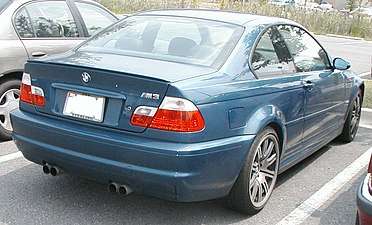 Coupe
Coupe.jpg) Convertible
Convertible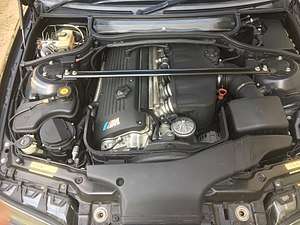 BMW S54 straight-six engine
BMW S54 straight-six engine
Engine
The 3.2 L (200 cu in) S54 engine is the final evolution of the BMW S50 naturally aspirated straight-six engine. The S54 is rated at 252 kW (338 hp) at 7,900 rpm, 365 N⋅m (269 lb⋅ft) at 4,900 rpm, and has a redline of 8,000 rpm.[53] As with most M engines, the S54 has an individual throttle bodies for each cylinder, with electronic throttle control (drive-by-wire) operation of the throttles being a new feature for the S54.
Development and launch
Concept design of the M3 began in 1997.[62] The head of exterior design was Ulf Weidhase and the head of interior design was Martina Bachmann.[62]
The M3 was previewed at the 1999 International Motor Show Germany[63] as a concept,[64] resembling the final production version very closely. The final production version was first introduced in October 2000 at the Geneva Motor Show,[65] it appeared worldwide with the new 3.2 L S54 M-tuned inline-6 engine.
Special editions
CSL

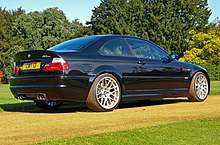
The BMW M3 CSL (Coupe Sport Leichtbau- translates to Coupe Sport Lightweight)[66] is a limited edition version of the M3 that was produced in 2004, with production totalling to 1,383 cars.[67] It was available in two colours: Silver Grey Metallic and Black Sapphire Metallic.[68]
As its name suggests, an emphasis was put on reducing weight. The CSL has a kerb weight of 1,385 kg (3,053 lb), 110 kg (243 lb) lighter than the regular M3.[69][70][71] Structural weight reduction measures include the use of glass-reinforced plastics in various structural points in the car,[70] a roof constructed from carbon fibre reinforced plastic (reducing kerb weight by 7 kg (15 lb) and, more importantly, lowering the centre of gravity),[68][69][72] body panels constructed from carbon fiber reinforced polymer[69] and thinner glass for the rear window.[73] The trunk floor cover was made of lightweight fibre-board (not cardboard as infamously described on the Top Gear television show). The CSL discarded a large proportion of the M3s sound insulation, the electric seats, navigation system, air conditioning and stereo (the latter two were able to be re-added as no-cost options).[70][74] The interior includes fibreglass front racing bucket seats,[69] a fibreglass backing for the rear seats,[69] and carbon fibre for the center console, door panels, door trim and head-liner,[68][69] The steering wheel has just a single button which activates the M track mode, instead of the buttons for cruise control, stereo, and phone controls on the regular M3.[68] The CSL retained the 50:50 weight distribution of the regular M3.[69]
The wheels were increased in size to 19 inches. BMW took the unusual approach of supplying the CSL with semi-slick tyres (Michelin Pilot Sport Cup).[68][75] These tyres provided high grip levels once warmed up on a racetrack, but poor performance on wet roads and when below their operating temperature.[76][77] A warning label was included in the CSL to inform drivers about driving in cold or wet conditions. The brakes were upgraded with larger floating rotors at the front and larger pistons at the rear.
The suspension system was revised with stiffer springs, upgraded shock absorbers and a quicker ratio for the steering rack (14.5:1 vs 15.4:1 on the regular M3).[69][78] The electronic stability control was retuned and an "M track mode" was added, allowing higher thresholds before the system intervened.
The engine used in the CSL had increased output over the regular S54 by 13 kW (17 hp) and 5 N⋅m (4 lbf⋅ft) over the European M3. This is due to the use of sharper profile camshafts, a bigger air intake with carbon fibre manifold, a refinement of the exhaust manifold, and slightly different exhaust valves.[68][78] The top speed was electronically limited as standard, but buyers with a current motorsport licence could order the CSL with the speed limiter removed.[78] The sole transmission available was the 6-speed SMG II automated transmission,[78] with revised software resulting in shift times of 80 milliseconds.[68]
The aerodynamics were also revised, including a carbon fibre front splitter that improved down force at high speeds by 50%,[69] and a carbon fibre rear diffuser. The front bumper had a distinct hole that is used to draw cool air into the newly designed air intake.[69] The trunk lid was redesigned to incorporate a raised lip, unlike the regular M3 where one is simply added onto a flat trunk.[69]
Competition Package / CS
In 2005, a special edition was introduced which used several parts from the CSL. This model was called the M3 Competition Package (ZCP) in the United States and mainland Europe, and the M3 CS in the United Kingdom.[65] Compared to the regular M3, the Competition Package includes:
- 19-inch BBS alloy wheels- 19"x8" at the front and 19"x9.5" at the rear.
- Stiffer springs (which were carried over to the regular M3 from 12/04).
- Faster ratio steering rack of 14.5:1 (compared with the regular M3's ratio of 15.4:1) as per the CSL
- Steering wheel from the CSL
- M-track mode for the electronic stability control, as per the CSL.
- The CSL's larger front brake discs (but with the regular M3 front calipers) and rear brake calipers with larger pistons.
- Alcantara steering wheel and handbrake covers.
The engine, gearbox and other drivetrain components are as per the regular M3 model.
GTR road car
In order to homologate the M3 GTR for racing, a road version was produced in 2001. BMW claimed to offer 10 cars for sale to the general public, at the very high price of €250,000.[79] However, only 6 cars were produced, of which 3 were development prototypes.[80] The road cars were built alongside the GTR race cars in the special vehicles department of BMW's Regensburg Plant.
As per the race car, the GTR road car was powered by the BMW P60B40 4.0 L (244 cu in) V8 engine. The engine retained the race cars' dry sump oil system and was slightly detuned from 330 to 285 kW (443 to 382 hp) at 7,000 rpm.[81] Top speed was 295 km/h (183 mph). The transmission was a six-speed manual and the differential was the same variable locking unit as used in the race car.
The dry weight was 1,350 kg (2,980 lb). Weight reduction measures included a carbon fibre front bumper, rear bumper and rear wing.
North American models
The North American models used the same S54 engine as in other countries (unlike the previous generation, which used lower performance engines in the United States). Due to minor differences in specification, the United States models were rated at 248 kW (333 hp) and 355 N⋅m (262 lb⋅ft), resulting in an official 0−60 mph (−97 km/h) acceleration time of 4.8 seconds for the coupe version (with either the manual and SMG transmission). As per other countries, top speed was electronically limited to 250 km/h (155 mph)[82][83]
The CSL model was not sold in the North American market.[74]
Motorsport
.jpg)
In the United States, the E46 M3 competed in the 2000 American Le Mans Series GT category and finished third in the championship. However, the straight-six engine was viewed as uncompetitive compared to the Porsche 996 GT3, therefore BMW began to develop a new M3 racing car based around a more powerful engine. The resulting E46 GTR racing car was introduced in February 2001 and was powered by a 330 kW (443 hp) version of the P60B40 3,997 cc (4.0 L) V8 engine.[80][84] With a more powerful engine than the straight-six powered M3 versions (which were outpaced by the competition), the GTR won the 2001 American Le Mans Series GT category, driven by Jörg Müller.
However, the eligibility of the GTR was the subject of controversy, with some rival teams believing that the GTR was an in-house prototype vehicle rather than production model available for purchase by the general public. The ALMS homologation rules for 2001 required the M3 GTR road car to be sold on at least two continents within twelve months of the rules being issued, which BMW claimed to fulfill by stating that 10 GTR road cars were available for sale. The ALMS rules were altered for 2002, now requiring that 100 cars and 1,000 engines must be built for the car to qualify without penalties. The GTR road car was never intended for production on this scale, so BMW withdrew the GTR from competition at this point.
In 2003, the M3 GTR returned to competition at the 24 Hours Nürburgring, with two cars run by Schnitzer Motorsport. The GTR won the 24 Hours Nürburgring in 2004 and 2005,[85]) and competed in the 24 Hours Spa.[86]
E90/E92/E93 generation (2007–2013)
| E90/92/93 M3 | |
|---|---|
_(cropped_II).jpg) | |
| Overview | |
| Production | 2007—2013 |
| Body and chassis | |
| Body style |
|
| Powertrain | |
| Engine | 4.0-4.4 L S65 V8 |
| Transmission | 6-speed manual 7-speed dual-clutch |
| Dimensions | |
| Wheelbase | 2,761 mm (108.7 in) |
| Length | 4,582–4,618 mm (180.4–181.8 in) |
| Width | 71.0–71.7 in (1,803–1,821 mm) |
| Height | 1,377–1,448 mm (54.2–57.0 in) |
The M3 model of the E90/E92/E93 3 Series range was powered by the BMW S65 V8 engine and was produced in sedan, convertible and coupe body styles. In the regular M3, the S65 engine generated 309 kW (414 hp) at 8,300 rpm[87] and 400 N⋅m (295 lb⋅ft) at 3,900 rpm.[87]
Initially, the M3 was produced with a 6-speed manual transmission. In April 2008, the E90/E92/E93 M3 became the first BMW to be available with a dual-clutch transmission when the 7-speed Getrag "M-DCT" transmission was introduced as an option.[88]
The official 0 to 100 km/h (62 mph) acceleration times for the coupe/sedan is 4.6 seconds with the DCT transmission (4.8 seconds with the manual transmission)[89] and 5.1 seconds for the convertible.[90]
The E90 and E92 versions received many positive reviews, including "the greatest all-around car in the world",[91] "the finest car on the market, period"[92] and "the best, most complete car in the world".[93]
Development and production
The coupé version was designed by Karl John Elmitt[94] and the sedan version was designed by Hans-Bruno Starke.
Total production was of the E9x M3 was 40,092 coupes, 16,219 convertibles and 9,674 sedans.[95] Production of sedan models finished in 2011,[96] with coupes remaining in production until July 5, 2013.
Body styles
The first body style to be introduced was the coupe, which was previewed at the 2007 Geneva Motor Show[97] and introduced in production form at the 2007 Frankfurt Motor Show on 12 September.[98] The coupe version uses a carbon-fibre roof to reduce weight and lower the centre of gravity. In 2010, the coupe and convertible versions received a minor facelift, which included revised headlights, LED tail-lights and minor interior trim pieces.[99]
The E93 convertible version was introduced shortly after the coupe and uses a power retractable hardtop. The leather seats in the convertible version are treated with a coating to reflect sunlight, in order to reduce their tendency to become uncomfortably hot with the top down.[100]
A sedan version was introduced in 2008 and was only the second generation (along with the E36) of M3 to be produced in a 4-door body style.[101] The sedan has the same drivetrain and similar external styling as the coupe, however the lack of a carbon-fibre roof contributes to a weight increase of 10 kg (22 lb) compared to an identically equipped coupé.
The official kerb weights for the 2008 models (with manual transmission) are 1,580 kg (3,483 lb) for the coupe, 1,605 kg (3,538 lb) for the sedan and 1,810 kg (3,990 lb) for the convertible.[102][103][104][105]
_sedan_05.jpg) Sedan (E90)
Sedan (E90)_(cropped).jpg) Coupe (E92)
Coupe (E92).jpg) Convertible (E93)
Convertible (E93)
Special editions
Competition Package (ZCP)
The "Competition Package" (sometimes known as ZCP) version was released in 2010. The changes related to the suspension and electronic stability control and consisted of:[106][107]
GTS
_(cropped).jpg)
_(cropped).jpg)
BMW announced the M3 GTS in November 2009 and began production in 2010. The GTS was designed as a "road-legal clubsport-oriented model" and produced only in the coupe body style. Changes over the regular M3 include an upgraded engine, reduced kerb weight, revised suspension, upgraded brakes and adjustable aerodynamics.
The GTS uses an engine enlarged to 4.4 L (269 cu in) which has a power output of 331 kW (444 hp). The sole transmission option was the 7-speed dual-clutch transmission (M-DCT) and the official 0–100 km/h (0–62 mph) acceleration time for the GTS is 4.4 seconds.[110]
The car weighs 136 kg (300 lb) less than the regular M3, a lighter centre console and door panels, polycarbonate side and rear windows, a lack of rear seats and the removal of acoustic insulation.
Suspension changes include adjustable camber angle and ride height, a rigidly mounted rear axle and revised dampers. The front brakes were upgraded to 6-piston calipers with 18 mm (0.7 in) larger rotors, and the rear brakes were upgraded to 4-piston calipers with 18 mm (0.7 in) larger rotors. Aerodynamics are adjustable via the front apron and the angle of the rear wing.
The GTS was significantly more expensive than the regular M3, for example the price was approximately €115,000 in the United Kingdom.[111] Production was limited to 135 cars, which sold out quickly.[112][113]
CRT
.jpg)
The M3 CRT (Carbon Racing Technology) was a special edition of the M3 sedan that was produced in 2011.[114] The CRT was powered by the same 4.4 litre version of the S65 engine as the GTS, however it retained a higher level of luxury features compared to the track-focussed GTS. The CRT used a carbon fibre bonnet (hood) and front seats to reduce weight, resulting in a kerb weight approximately 150 lb (68 kg) lower than an equivaliently specified version of the regular M3 sedan.
Production was limited to 67 cars, all numbered with a plaque on the dashboard. The official 0–100 km/h (0–62 mph) acceleration time was 4.4 seconds.[115]
DTM Champion Edition
BMW Motorsport returned to the DTM in 2012, and 54 "DTM Champion Edition" cars were built to commemorate the BMW M3 winning the championship.[116] The unique features of the DTM Champion Edition consisted of visual changes to associate the car with the DTM race car, such as the "Frozen Black" paint colour, stripes over the roof and boot lid, carbon flaps and gurney and matt black wheels. Interior changes included carbon fibre for some interior trim items, an "M Power" logo embroidered on the handbrake grip and a numbered plaque with Spengler's signature and the text "DTM champion 2012" above the glove box. All cars were produced with the dual-clutch transmission.
Lime Rock Park Edition (U.S.)
.jpg)
In the United States, the M3 Lime Rock Park Edition was produced for the 2013 model year. A total of 200 cars were sold, all coupes painted in the "Fire Orange" colour. Performance changes included a carbon fibre front splitter and rear spoiler, the ride height lowered by 0.6 in (15 mm), a faster steering ratio, higher thresholds for the electronic stability control and a lightweight exhaust system. BMW claims the same engine power output as the regular M3, however, when marketing the lightweight Inconel-titanium BMW Motorsports Exhaust to stock M3 vehicles, BMW Claims that the system adds about 5 hp (4 kW).
The interior of the Lime Rock Park Edition includes a plaque reading "One of 200".[117]
Frozen Edition
Due to the GTS version not being available in South Africa, BMW developed the BMW M3 Frozen Edition in 2009. The engine was upgraded to generate 330 kW (443 hp), due to an AC Schnitzer intake manifold and changes to the engine management system.
Twenty-five Frozen Edition cars were produced, all with exterior colours of either "Frozen Black" or "Frozen Grey".[118]
Competition Edition Frozen Silver
In 2012, BMW announced this edition with 40 to be built for US and 100 for Europe. Built to commemorate the 40th anniversary of BMW's M Division. Each model will come with Frozen Silver Metallic exterior paint, according to BMW, is a special matte paint that adds a metallic luster to the vehicle. The interior has black leather and palladium silver accessories in the interior.[119]
M3 Pickup Prototype
The M3 Pickup is a one-off custom variant of the M3 which was based on the E93 M3 convertible and publicly announced on April Fool's Day in 2011. It was used as a workshop transport vehicle for BMW M GmbH, replacing their E30 M3 pickup version after 26 years of use.[15][120] The vehicle was assembled by M GmbH's employees, as well as interns and engineering students.[121]
Motorsport
The E92 M3 saw BMW return to the Deutsche Tourenwagen Masters (DTM) after a break of 20 years. In its debut season in 2012, the M3 won the drivers championship, the manufacturers championship and five out of ten races for the season.[122][123]
In endurance racing, the BMW Motorsport/Schnitzer Motorsport M3 GT2 won the 2010 24 Hours of Nürburgring, driven by Jörg Müller, Augusto Farfus, Pedro Lamy, and Uwe Alzen. The M3 also qualified 2nd at the 2010 24 Hours of Spa and led the race until being forced to retire in the final hour due to suspension failure. The M3 won the GT2 category in the ILMC 2010 1000 km of Zhuhai in China.
A GT4 version of the M3 was introduced in 2009 and competed in various races, including finishing third in the GT4 SP10 class at the 2009 24 Hours Nürburgring,[124][125][126] and winning its class at the ADAC Westfalenfahrt race at the Nürburgring in April 2009. In July 2009, BMW Motorsport released an M3 GT4 model for sale to private teams and drivers.[127] The official kerb weight was 1,430 kg (3,153 lb) and changes to the 336 kW (451 bhp) were claimed to be minimal.[128] For the 2010 24 Hours Nürburgring, the "Balance of Performance" required the M3 to not exceed a power output of 287 kW (385 bhp) and to have a minimum weight of 1,400 kg (3,086 lb).[129]
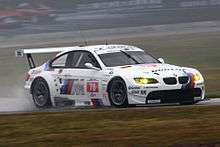
In the United States, Rahal Letterman Racing entered two factory-backed E92 M3s in the 2009 American Le Mans Series season, competing in the GT2 category. In 2011, the BMW achieved a 1-2 finish in the 12 Hours of Sebring. In the 2011 American Le Mans Series GT class, BMW Team RLL swept all categories, winning the GT manufacturer, team and driver championships. In 2012, the M3 won the GT class at the 12 Hours of Sebring. The #79 M3 GT2 that competed at Le Mans became the 17th BMW Art Car after it was decorated by Jeff Koons.[130] The M3 GT2 was succeeded by the BMW Z4 GTE in 2013.
F80 generation (2014–2018)
| F80 M3 | |
|---|---|
_sedan_(2018-08-31)_01.jpg) | |
| Overview | |
| Production | 2014–2018 |
| Body and chassis | |
| Body style | 4-door sedan |
| Powertrain | |
| Engine | 3.0 L S55 twin-turbo I6 |
| Transmission | 6-speed manual 7-speed dual-clutch |
| Dimensions | |
| Wheelbase | 2,812 mm (110.7 in) |
| Length | 4,671 mm (183.9 in) |
| Width | 1,877 mm (73.9 in) |
| Height | 1,424 mm (56.1 in) |
The M3 version of the F30 3 Series was designated the F80 and was produced from 2014–2018.[131] The F80 M3 was powered by the BMW S55 twin-turbocharged straight-six engine, therefore being the first turbocharged M3 model. Despite the smaller displacement than the V8 engine used by the previous generation of M3, the switch from naturally aspirated engines to turbocharging resulted in peak power being increased from 309 to 317 kW (414 to 425 bhp), and peak torque being increased from 400 to 550 N⋅m (295 to 406 lb⋅ft).
The official 0–97 km/h (0–60 mph) acceleration times are 3.9 seconds with the M-DCT transmission and 4.1 seconds with the manual transmission.[132] Top speed is limited to 250 km/h (155 mph) but an optional M Driver's package raises this to 280 km/h (174 mph).
The F80 M3 was unveiled, alongside the F82 M4 (its coupé counterpart), at the 2014 North American International Auto Show.[133]
In 2016, a Competition Package became available for the M3 and M4. Changes included an increase in power to 331 kW (444 hp), revised tuning of the electronic differential and the electronic stability control ("DSC"), suspension upgrades and new front seats.[134][135] The official 0–100 km/h (0–62 mph) time was 4.0 seconds with the dual-clutch transmission.[135]
.jpg) F80 M3- rear view
F80 M3- rear view.jpg) BMW S55 straight-six engine
BMW S55 straight-six engine
Body styles
The F80 generation of M3 was produced only as a sedan, following the company's plans to split off the BMW 4 Series coupé/convertible from the BMW 3 Series.[136] To minimise weight, the roof is made of carbon fibre and the bonnet and front quarter panels are made from aluminium.[137] The kerb weight was 1,621 kg (3,574 lb) with the manual transmission or 1,647 kg (3,631 lb) with the dual-clutch transmission.
Special editions
M3 Pure
The Australian-only M3 Pure model was sold as the base model, being A$12,500 cheaper than the regular M3.[138] The M3 Pure has the engine, exhaust and suspension from the Competition Package. Exterior trims include black badges, front grills, side gills and exhaust tips, while the interior trim uses a combination of leather and cloth.
M3 CS
.jpg)
An "M3 CS" special edition was produced in 2018 with an upgraded engine rated at 339 kW (454 hp) and 601 N⋅m (443 lb⋅ft). The weight was reduced by 50 kg (110 lb) through use of a carbon fibre front spoiler, Alcantara interior parts and thinner glass for the side windows.
Production of the CS totalled 1,200 units.[139]
Motorsport
With the M3 model now being solely a sedan body style, the motor racing activities switched to the M4 (F82) coupé.
G20 based generation
BMW have announced that an M3 version of the G20 3 Series is due to begin sales in 2021, powered by the BMW S58 turbocharged straight-six engine that debuted in the F97 X3 M.[142][143] All-wheel drive (xDrive) has been announced as being optional on the new M3,[144] which would represent the first time that an M3 has used a drivetrain layout other than rear-wheel drive.[145] A manual gearbox will be available only with rear wheel drive. [146]
Production volumes
| Version | E30[17][13] 1986-1991 |
E36[47] 1992-1999 |
E46[60] 2000-2006 |
E9x[95] 2007-2013 |
F80[147] 2014-2018 |
|---|---|---|---|---|---|
| Sedan | 12,603 | 9,674 | 34,677 | ||
| Coupe | 17,184 | 46,525 | 56,133 | 40,092 | |
| Convertible | 786 | 12,114 | 29,633 | 16,219 | |
| Total | 17,970 | 71,242 | 85,766 | 65,985 | 34,677 |
References
- "BMW M3 Celebrating 20 Years of a Sporting Legend". worldcarfans.com. 27 February 2008. Archived from the original on 29 March 2012. Retrieved 27 February 2012.
- "BMW M3 – The Evolution of the Benchmark". clubsportiva.com. 27 February 2012. Archived from the original on 18 September 2011. Retrieved 8 April 2011.
- "FAQ E30 M3". www.bmwmregistry.com. Retrieved 8 April 2019.
- "3'E30 model selection: convertible - M3 - EUR - 1991". www.realoem.com. Retrieved 1 June 2019.
- Walton, Jeremy. BMW 3-Series Enthusiast's Companion. Bentley Publishers, 2001, pp. 121–123, ISBN 0-8376-0220-3
- "1986 BMW M3". Retrieved 30 September 2014.
- "1988 BMW M3 Cabrio". Retrieved 30 September 2014.
- Mandel, Dutch (20 July 1987). "M Times Three = Performance" (PDF). Autoweek: 29–31. Retrieved 11 February 2020.
- "1990 BMW M3 Sports Evolution (Evolution III)". Retrieved 30 September 2014.
- "BMW S14B23 automotive engine". bmw-grouparchiv.de. Retrieved 17 June 2019.
- Kittler, Eberhard (2001). Deutsche Autos seit 1990, vol.5. Stuttgart: Motorbuch. p. 130. ISBN 3-613-02128-5.
- "E30 M3 FAQ". BMW M Registry. Retrieved 4 October 2016.
- "bmw m registry - faq E30 M3". www.bmwmregistry.com. Archived from the original on 19 June 2017. Retrieved 4 August 2017.
- "European Supertest: German Thundercars". Road & Track. Retrieved 4 October 2016.
- "30 years of the BMW M3 – the story behind the legend". www.press.bmwgroup.com. Retrieved 25 June 2017.
- Patel, Joel. "BMW actually built two M3-based pickup trucks". Autoblog. Retrieved 25 June 2017.
- "bmw m registry - faq E30 M3 'Convertible'". www.bmwmregistry.com. Retrieved 4 August 2017.
- "1988 Cars". Retrieved 15 August 2016.
- "1991 Cars". Retrieved 15 August 2016.
- "3' E36 M3 Manual gearbox S6S 420G". www.realoem.com. Retrieved 19 April 2019.
- "FAQ E36 M3 3.2". BMW M Registry. Archived from the original on 19 June 2010. Retrieved 20 June 2010.
- "The BMW 3 Series Coupés" (PDF). BMW. 1996. p. 28. Retrieved 19 February 2019.
- "3' E36 M3 Manual Transmission S6S 420G (SMG)". www.realoem.com. Retrieved 4 May 2019.
- "1992-2000 E36 BMW M3 Review". www.topspeed.com. Retrieved 4 May 2019.
- Auto Motor and Sport, 13/1996, pages 38–40
- "1997 BMW M3 Coupé specifications". www.automobile-catalog.com. Retrieved 18 June 2018.
- "Video: BMW E36 M3 GT Reviewed by Carfection". www.bmwblog.com. 22 April 2019. Retrieved 26 April 2019.
- "The BMW M3 GT Is the Best E36 You Might Not Know About". www.roadandtrack.com. 24 April 2019. Retrieved 26 April 2019.
- "Driving A Dream Car: The Limited Edition BMW E36 M3 GT". www.petrolicious.com. 30 June 2017. Retrieved 26 April 2019.
- https://bmwmregistry.com/model_faq.php?id=15
- "BMW M3 Evo Individual". Retrieved 2 December 2019.
- "The E36 M3 LTW CSL: A Rare M3, Just For The US". www.speedhunters.com. 13 March 2019. Retrieved 26 April 2019.
- "For Sale: 1995 BMW E36 M3 Lightweight". www.bmwblog.com. 8 August 2016. Retrieved 26 April 2019.
- "1995 M3 Lightweight Service Bulletin". BMW North America. Archived from the original on 6 June 2009. Retrieved 12 June 2009.
- "BMW M3 Style 24 wheels". Retrieved 25 June 2019.
- "1995 BMW M3 Lightweight". www.sportscarmarket.com. Retrieved 26 April 2019.
- "100-Mile 1995 BMW M3 Lightweight". www.bringatrailer.com. Retrieved 26 April 2019.
- "The Canadian M3". www.hagerty.com. Retrieved 26 April 2019.
- "How Canada Got the Euro-Spec E36 M3 America Didn't". www.roadandtrack.com. 19 October 2017. Retrieved 26 April 2019.
- "1 of 45: 1994 BMW M3 Canadian Edition". www.germancarsforsaleblog.com. 18 August 2016. Retrieved 26 April 2019.
- "M3 E36 Gtr". www.bmwfaq.org (in Spanish). Retrieved 26 April 2019.
- "bmw m3 gtr 1994 Barbuza". www.barbuza.com. Retrieved 26 April 2019.
- https://www.motorsportmagazine.com/archive/article/september-1991/42/road-test-bmw-325-i
- https://www.bmwmregistry.com/model_faq.php?id=14
- https://bmwmregistry.com/model_faq.php?id=15
- "FAQ E36 M3 3.2". BMW M Registry. Archived from the original on 16 June 2009. Retrieved 12 June 2009.
- "The History Of BMW M3". 16 October 2015. Archived from the original on 27 December 2016. Retrieved 4 August 2017.
- "3' E36 M3 Automatic transmission A5S310Z". www.realoem.com. Retrieved 4 May 2019.
- "Model selection: 3'E36 - coupe - M3 - USA - 10/1995". www.realoem.com. Retrieved 19 April 2019.
- All figures: Covello, Mike (2002). Standard Catalog of Imported Cars 1946–2002. Iola: Krause Publications. pp. 160–163. ISBN 0-87341-605-8.
- "DriverDatabase". www.driverdb.com.
- James, James Taylor (31 July 2014). BMW M3: The Complete Story. ISBN 9781847977731. Retrieved 5 June 2017.
- "BMW M3 Cabriolet (E46) 2001 - 2007". autoevolution. Retrieved 12 January 2015.
- Tomalin, Peter (25 January 2013). "BMW M3 E46 buying guide". Evo. Retrieved 12 January 2015.
- "2002 BMW M3 vs. 2008 BMW 135i vs. 2008 BMW 335i Comparison Test". Edmunds.com. 27 April 2008. Archived from the original on 28 June 2009. Retrieved 12 June 2009.
- Car & Driver Magazine, January 2002
- "2000 BMW M3 E46 car specifications, auto technical data - performance, fuel economy, emissions, dimensions". www.carfolio.com. Retrieved 28 April 2019.
- "3' E46 M3 Manual Transmission S6S 420G (SMG)". www.realoem.com. Retrieved 4 May 2019.
- "BMW M3". www.roadandtrack.com. 6 November 2012. Retrieved 4 May 2019.
- "BMW M Registry - FAQ E46 M3". www.bmwmregistry.com. Archived from the original on 7 July 2017. Retrieved 4 August 2017.
- https://bmwmregistry.com/model_faq.php?id=19
- "Pushing the boundaries. The design of the new BMW M3" (PDF). Archived from the original (PDF) on 28 June 2001. Retrieved 16 December 2016.
- Klauder, Kai. "IAA 1999: Neue Partnerschaften und ein SLR als Wow-Auto". auto motor und sport (in German). Retrieved 28 February 2018.
- "IAA 1999 - Focus on the BMW Booth". audiworld. Retrieved 28 February 2018.
- "FAQ E46 M3". BMW M Registry. Retrieved 7 April 2012.
- "Tut uns Light". Archived from the original on 13 March 2012. Retrieved 16 December 2016.
- "BMW M3 CSL (E46)". bmw-grouparchiv.de. Retrieved 15 June 2018.
- "BMW M3 Parts CSL". US auto parts. Archived from the original on 23 September 2009. Retrieved 10 July 2009.
- "BMW M3 CSL". Cartorque. Retrieved 10 July 2009.
- "BMW M3 CSL (E46)". diseno-art. Archived from the original on 21 June 2009. Retrieved 10 July 2009.
- "Car reviews – BMW M3 CSL". Archived from the original on 27 September 2011. Retrieved 16 December 2016.
- "BMW M3 CSL". Automobile magazine. Archived from the original on 5 June 2009. Retrieved 10 July 2009.
- "Top Gear". BBC. Retrieved 3 January 2012./
- "BMW M3 CSL Performance". Automobile Magazine. Archived from the original on 4 June 2009. Retrieved 10 July 2009.
- "BMW M3 CSL – Auto Shows". Car and driver. Retrieved 10 July 2009.
- "The BMW M3 CSL Is Still a Dream Machine". www.roadandtrack.com. 29 April 2019. Retrieved 5 May 2019.
- "BMW E46 M3 CSL Review". www.tradeuniquecars.com.au. Retrieved 5 May 2019.
- "The New M3 CSL", Car pages
- "The BMW M3 GTR Bent the Rules to Beat Everyone". www.roadandtrack.com. 16 October 2018. Retrieved 7 May 2019.
- "2001 BMW M3 GTR Race and Road Cars To Be Presented at Legends of the Autobahn Concours D'Elegance". press.bmwgroup.com. Retrieved 25 August 2017.
- BMW M3 GTR. BMW AG. November 2001. p. 5. Retrieved 25 August 2017.
- BMW M3 Owners Manual
- "BMW M3: A Brief History of the Ultimate Driving Machine". www.motortrend.com. Retrieved 4 May 2019.
- "BMW M3 GTR". caranddriver.com. Retrieved 25 August 2017.
- BMW M3 E46 GTR / Rennsaison 2004 – 2005 (PDF). 2005. Retrieved 25 August 2017.
- "BMW M3 E46: Respecting the past - embracing the future". www.bmw-m.com. Retrieved 8 May 2019.
- "2011 Audi RS5 vs. 2010 BMW M3, 2011 Cadillac CTS-V – Comparison Tests" (PDF). Caranddriver. August 2010. Retrieved 7 September 2010.
- "The new M double-clutch transmission with Drivelogic". www.press.bmwgroup.com.
- "BMW Technical Data". BMW. Archived from the original on 13 November 2013. Retrieved 11 November 2013.
- "BMW M3 Convertible Technical Data". BMW. Archived from the original on 16 June 2009. Retrieved 22 November 2017.
- "E90 M3 Long-Term Test". motortrend.com. Retrieved 8 August 2009.
- "BMW M3 Long-Term: The Perfect Sports Car?". Car and Driver. Archived from the original on 14 January 2010. Retrieved 1 December 2009.
- "BMW M3: Best Car in the World". InsideLine.com. Archived from the original on 10 November 2009. Retrieved 7 November 2009.
- "MONDIAL – BMW Série 3 : si vous avez manqué le début… – LIGNES/auto".
- "BMW M Registry - FAQ E90 + E92 + E93 M3". www.bmwmregistry.com. Archived from the original on 22 October 2016. Retrieved 4 August 2017.
- "Model selection - 3'E90 LCI - saloon - M3 - EUR". www.realoem.com. Retrieved 18 September 2019.
- "BMW M3 Concept (2007): first official pictures". CAR Magazine. Retrieved 13 August 2018.
- "Die Highlights". Der Tagesspiegel Online (in German). 27 August 2007. Retrieved 13 August 2018.
- "Photo Comparison: E92 Coupe facelift vs. pre-facelift". www.bmwblog.com. 17 January 2010. Retrieved 9 June 2019.
- "2010 BMW M3 Convertible Review". Automoblog.net.
- "BMW M3 Sedan Quick Review". www.bmwblog.com. 18 October 2007. Retrieved 9 June 2019.
- "2008 BMW M3 E92 (Coupe) full range specs". www.automobile-catalog.com. Retrieved 28 May 2019.
- "2008 BMW M3 E90 Sedan full range specs". www.automobile-catalog.com. Retrieved 28 May 2019.
- "2008 BMW M3 E93 (Cabrio) full range specs". www.automobile-catalog.com. Retrieved 28 May 2019.
- "BMW AG PRESSE". BMW AG PRESSE M3 (ALL GENERATIONS) TECHNICAL SPECIFICATION. BMW AG. Retrieved 25 June 2013.
- "First Drive: 2011 BMW M3 with Competition Package". www.motortrend.com. 28 May 2010. Retrieved 9 June 2019.
- "2011 BMW M3 Competition Package Review: Car Reviews". www.autoguide.com. Retrieved 9 June 2019.
- "2011 BMW M3 Competition Package Review: Car Reviews". www.autoguide.com. Retrieved 12 November 2019.
- "BMW M3 Competition Package (2010) review". www.carmagazine.co.uk. Retrieved 12 November 2019.
- "All clear given for market launch of the BMW M3 GTS". BMW PressClub. Retrieved 19 November 2016.
- "BMW M3 GTS is the most extreme M3 ever". Archived from the original on 19 July 2011. Retrieved 6 November 2009.
- "Sold Out: 2011 BMW M3 GTS". Gtspirit.Com. 2 January 2010. Archived from the original on 6 June 2010. Retrieved 5 June 2010.
- "Approaching the Checkered Flag: The 4th Generation BMW M3 Ends Its Production Run While Its Racing Career Continues" (Press release). BMW. 5 July 2013. Retrieved 14 November 2014.
- "2012 BMW M3 CRT Lightweight Sedan – Official Photos and Info".
- "BMW M3 CRT saloon review and pictures". EVO. Retrieved 19 November 2016.
- "BMW M celebrates DTM triumph with BMW M3 DTM Champion Edition model". BMW Group, press release. 5 December 2012. Retrieved 21 May 2013.
- "2013 BMW M3 Coupe Lime Rock Park Edition". Automoblog.net. 31 July 2012. Retrieved 9 July 2012.
- "Scorching Frozen Edition M3 driven". Wheels. Retrieved 5 May 2018.
- https://www.caranddriver.com/photos/g18150365/2012-bmw-m3-competition-edition-frozen-silver-announced-just-40-to-be-built-gallery/
- Lavrinc, Damon. "Officially Official: 420-HP BMW M3 Pickup hauls ass, nearly 1,000 pounds". Autoblog. Retrieved 25 June 2017.
- "The Full Scoop on BMW's April Fools' M3 Pickup". caranddriver.com. Archived from the original on 3 August 2017.
- "2012 season". www.dtm.com. 26 April 2015. Retrieved 12 June 2019.
- "BMW Wins DTM 2012 Championship". www.bmwblog.com. 21 October 2012. Retrieved 12 June 2019.
- "37. ADAC Zurich 24h Rennen" (PDF) (in German). 21–24 May 2009. Archived from the original (PDF) on 26 July 2011. Retrieved 13 January 2011.
- "24h-Klassen_123" (PDF). Archived from the original (PDF) on 14 April 2010. Retrieved 5 June 2010.
- "24h-Gesamt_123" (PDF). Archived from the original (PDF) on 2 June 2010. Retrieved 5 June 2010.
- "M3 GT4 Brochure and Specs". www.m3post.com. Retrieved 22 November 2017.
- "BMW M3 GT4". Archived from the original on 11 April 2012. Retrieved 15 August 2016.
- "Balance of Performance – 38. ADAC Zurich 24h-Rennen". Adac.24h-rennen.de. Archived from the original on 14 May 2010. Retrieved 5 June 2010.
- "BMW returning to American Le Mans Series". AutoWeek. 6 February 2008. Retrieved 6 February 2008.
- Tingwall, Eric (25 September 2013). "10 Things You Need to Know About the 2015 BMW M3 / M4". Car and Driver. Retrieved 29 April 2014.
- "First look: 2014 BMW M3 and M4". www.autoweek.com. 10 December 2013. Retrieved 18 June 2019.
- "Geneva Motor Show 2013: BMW". Retrieved 30 September 2014.
- "First drive: the BMW M3 'Competition Pack'". "Top Gear". Retrieved 5 February 2018.
- "Confirmed: M Version of BMW 4-series Coupe to be Called M4 – News – Car and Driver – Car and Driver Blog". Retrieved 30 September 2014.
- Kable, Greg (6 August 2012). "Revolutionizing the M3". Autoweek. 62 (16): 8–9. Retrieved 8 August 2012.
- Maclean, Andrew (25 February 2018). "2018 BMW M3 Pure quick spin review - Quick Spin: BMW's bargain muscle car". Drive. Retrieved 24 July 2019.
- Horatiu Boareu (7 November 2017). "First video of the BMW M3 CS". Retrieved 28 March 2018.
-
"BMW M3 by Björn Schmidt". bmw-m.com. M GmbH. 30 October 2018. Retrieved 10 August 2019.
production of the current generation BMW M3 (F80) will be coming to an end. Someone else who finds it just as difficult to say goodbye is self-confessed BMW M enthusiast Björn Schmidt. But he’s found a way to deal with it: as a birthday treat, the businessman has secured himself the last model in Europe.
- "Production Data Shows Only 15% of BMW F80 M3 Models Were Manual". BMW BLOG. 14 January 2019. Retrieved 29 April 2019.
- "2021 BMW M3 and M4: Everything We Know". www.roadandtrack.com. 28 October 2019. Retrieved 31 October 2019.
- "New BMW M3 not until 2021". www.carsales.com.au. Retrieved 31 October 2019.
- "Upcoming BMW G80 M3 will come with an imposing kidney grille". www.bmwblog.com. 7 August 2019. Retrieved 23 September 2019.
- "New 2020 BMW M3: choice of 480 or 510bhp, 2wd or 4wd confirmed". www.carmagazine.co.uk. Retrieved 18 September 2019.
- Perkins, Chris (22 November 2019). "BMW M Boss Confirms Rear-Drive Manual Version of Next M3 and M4". Road & Track. Retrieved 3 January 2020.
- https://f80.bimmerpost.com/forums/showpost.php?p=23945730&postcount=1
| Wikimedia Commons has media related to BMW M3. |